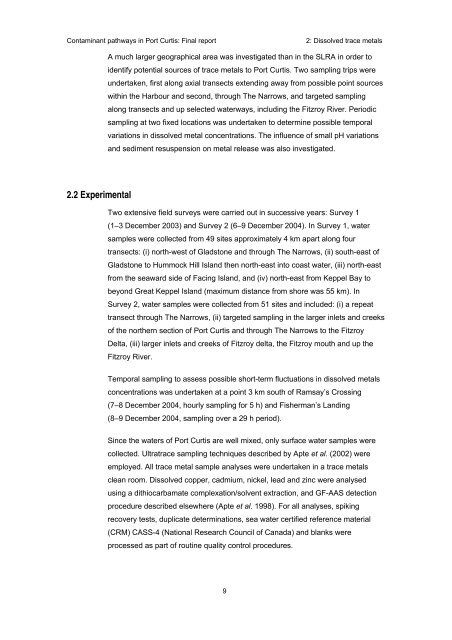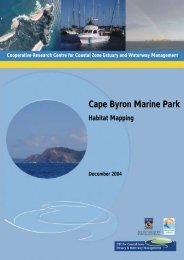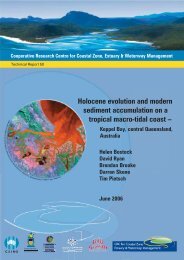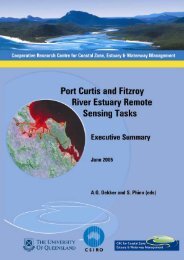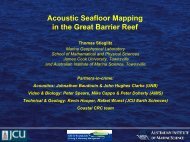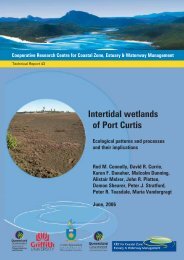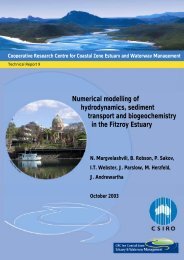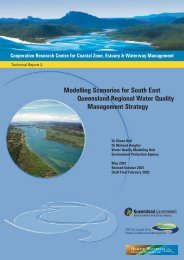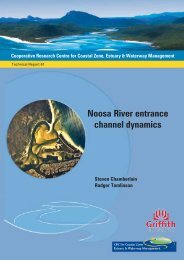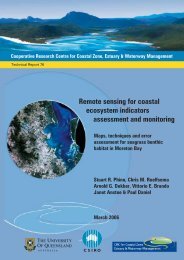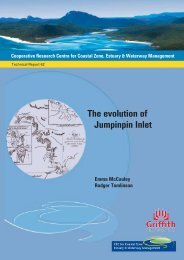Contaminant pathways in Port Curtis: Final report - OzCoasts
Contaminant pathways in Port Curtis: Final report - OzCoasts
Contaminant pathways in Port Curtis: Final report - OzCoasts
Create successful ePaper yourself
Turn your PDF publications into a flip-book with our unique Google optimized e-Paper software.
<strong>Contam<strong>in</strong>ant</strong> <strong>pathways</strong> <strong>in</strong> <strong>Port</strong> <strong>Curtis</strong>: F<strong>in</strong>al <strong>report</strong>2: Dissolved trace metalsA much larger geographical area was <strong>in</strong>vestigated than <strong>in</strong> the SLRA <strong>in</strong> order toidentify potential sources of trace metals to <strong>Port</strong> <strong>Curtis</strong>. Two sampl<strong>in</strong>g trips wereundertaken, first along axial transects extend<strong>in</strong>g away from possible po<strong>in</strong>t sourceswith<strong>in</strong> the Harbour and second, through The Narrows, and targeted sampl<strong>in</strong>galong transects and up selected waterways, <strong>in</strong>clud<strong>in</strong>g the Fitzroy River. Periodicsampl<strong>in</strong>g at two fixed locations was undertaken to determ<strong>in</strong>e possible temporalvariations <strong>in</strong> dissolved metal concentrations. The <strong>in</strong>fluence of small pH variationsand sediment resuspension on metal release was also <strong>in</strong>vestigated.2.2 ExperimentalTwo extensive field surveys were carried out <strong>in</strong> successive years: Survey 1(1–3 December 2003) and Survey 2 (6–9 December 2004). In Survey 1, watersamples were collected from 49 sites approximately 4 km apart along fourtransects: (i) north-west of Gladstone and through The Narrows, (ii) south-east ofGladstone to Hummock Hill Island then north-east <strong>in</strong>to coast water, (iii) north-eastfrom the seaward side of Fac<strong>in</strong>g Island, and (iv) north-east from Keppel Bay tobeyond Great Keppel Island (maximum distance from shore was 55 km). InSurvey 2, water samples were collected from 51 sites and <strong>in</strong>cluded: (i) a repeattransect through The Narrows, (ii) targeted sampl<strong>in</strong>g <strong>in</strong> the larger <strong>in</strong>lets and creeksof the northern section of <strong>Port</strong> <strong>Curtis</strong> and through The Narrows to the FitzroyDelta, (iii) larger <strong>in</strong>lets and creeks of Fitzroy delta, the Fitzroy mouth and up theFitzroy River.Temporal sampl<strong>in</strong>g to assess possible short-term fluctuations <strong>in</strong> dissolved metalsconcentrations was undertaken at a po<strong>in</strong>t 3 km south of Ramsay’s Cross<strong>in</strong>g(7–8 December 2004, hourly sampl<strong>in</strong>g for 5 h) and Fisherman’s Land<strong>in</strong>g(8–9 December 2004, sampl<strong>in</strong>g over a 29 h period).S<strong>in</strong>ce the waters of <strong>Port</strong> <strong>Curtis</strong> are well mixed, only surface water samples werecollected. Ultratrace sampl<strong>in</strong>g techniques described by Apte et al. (2002) wereemployed. All trace metal sample analyses were undertaken <strong>in</strong> a trace metalsclean room. Dissolved copper, cadmium, nickel, lead and z<strong>in</strong>c were analysedus<strong>in</strong>g a dithiocarbamate complexation/solvent extraction, and GF-AAS detectionprocedure described elsewhere (Apte et al. 1998). For all analyses, spik<strong>in</strong>grecovery tests, duplicate determ<strong>in</strong>ations, sea water certified reference material(CRM) CASS-4 (National Research Council of Canada) and blanks wereprocessed as part of rout<strong>in</strong>e quality control procedures.9


